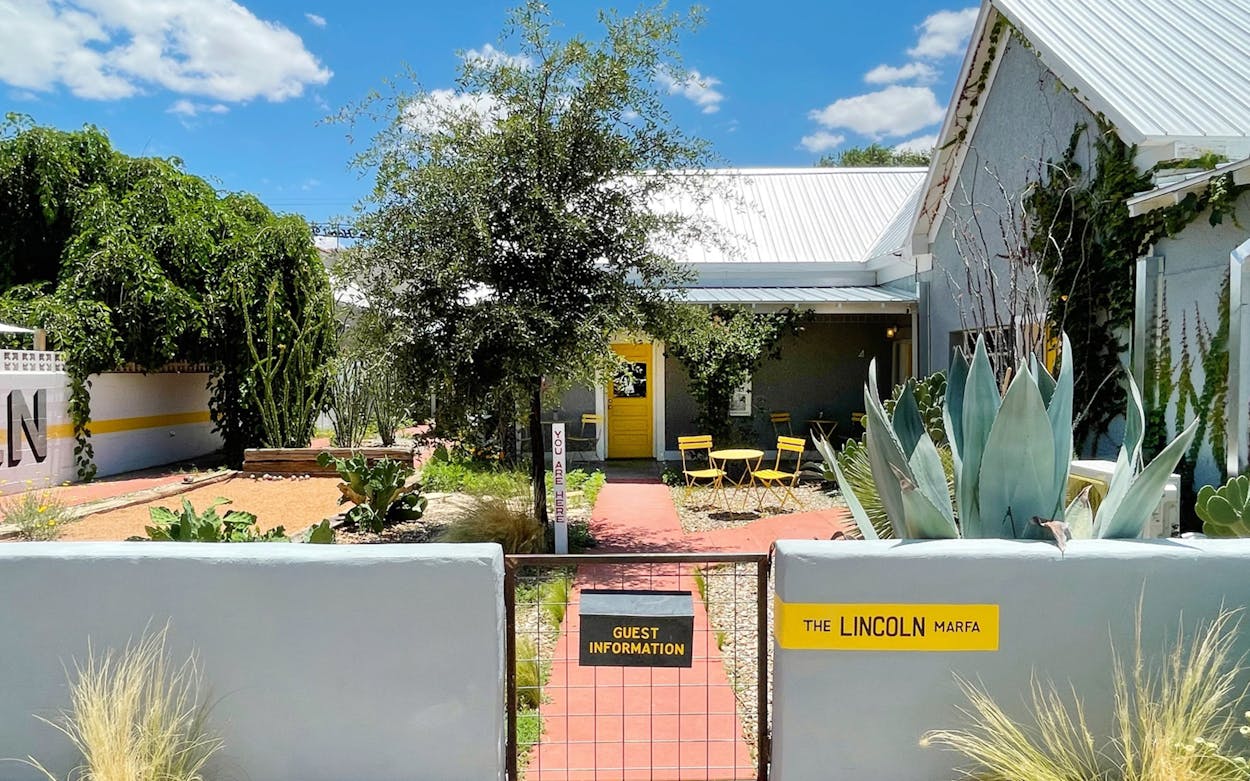When my boyfriend and I first opened the door to the Cold War–era bomb shelter and stared down the concrete steps, I’ll admit I had second thoughts about staying the night. It wasn’t that the space was uninviting. To get to our room, we’d walked past a bubbling koi pond, flowering cacti, and a bright yellow bistro set. And as far as bomb shelter entrances go, this one was nice—no cumbersome trapdoor or musty smell. What was holding me back was a mild case of claustrophobia. After all, you don’t come to Texas—especially not West Texas—to be boxed in.
Clark Childers and Adam Walton knew this might be a concern when they decided to restore the roughly one-hundred-square-foot fallout shelter, believed to be from the late fifties or early sixties, and turn it into a rental property.
“We absolutely had some hesitation around whether someone would want to stay there. But we also knew that we were in Marfa, a special place where people are looking for something different,” says Walton, adding that many guests seek out the underground digs over the duo’s more traditional, aboveground offerings at the Lincoln, a colorful complex consisting of short- and long-term rentals on Marfa’s downtown Lincoln Street.
Childers, a screenwriter who grew up in Corpus Christi, first came to West Texas to help run the Marfa Film Festival. He stayed a year and then headed to Hollywood, where he met Walton, an actor. Later, on a road trip, the couple stopped in Marfa and discovered a commune-style property for sale. It was a hodgepodge of buildings, some dating as far back as the 1800s, on land that once served as the stable yards for the nearby Presidio County courthouse. No one had lived there in decades.
“The place looked like it had suffered from an atomic evacuation,” Walton says, only half joking. “All the spaces were completely abandoned with food still in fridges, beds still made—it was really strange, a little corner of Marfa that had kind of just been forgotten.”
On a whim, they submitted an offer and won. Childers and Walton had no professional remodeling experience, but their industrial design aesthetic meshed well with “Marfa modernism.” The fallout shelter was the last building they renovated and their biggest challenge.
“There was a creepy hatch door and then you went down into this darkness,” Childers says. “Any remnants of a functioning bomb shelter had long been removed.”
They had a clean slate, consisting of cinder blocks and steel beams, and everyone had suggestions for what the bomb shelter should become—extra storage, a speakeasyesque wine cellar. Childers and Walton decided to honor its history.
During World War II, Marfa had a large military presence (Donald Judd’s famed Chinati Foundation occupies what was once an Army fort). As the Cold War dawned, residents were concerned that the town or its neighbor El Paso might become a target. The Lincoln’s bomb shelter isn’t the only holdover in town, but it’s the only one tourists can stay in. In fact, when Childers and Walton first opened their bunker to the public in 2018, they couldn’t find anything else like it. (My research revealed that a New Mexico bunker has since joined Airbnb, but Marfa’s is more affordable, at $165 a night—and cuter).


Childers and Walton spent the better part of three months outfitting the bunker. After figuring out some of the trickier logistics—like how to defy gravity with plumbing and run electrical without drilling into the cinder blocks—they got to the best part: decorating. The couple chose to eschew more literal accessories, like gas masks, in favor of creating a “fun throwback space.” Next to the double bed, two industrial-style sconces provide reading light with bare bulbs that have a mercurylike coating to add visual interest. In a town that sometimes has limited dining hours, a kitchen was a necessity, so Childers and Walton commissioned a local welder to design a compact kitchenette that fits a hot plate, a retro-inspired baby-blue minifridge, and a matching microwave. Above a deep sink that serves as a place to both do dishes and brush your teeth, there’s a vintage medicine cabinet with engraved flowers. Plus, the space has a small dining table with seating for two.
Other comforts from life aboveground include a French press and the couple’s favorite blend from nearby Big Bend Coffee Roasters, a floor-length mirror (Would it shatter in a blast? I wondered), a wine-bottle opener, and a can opener (What would a bomb shelter be without a can opener?). Still, my favorite element was the art.
Childers and Walton have curated a collection that includes a tiny landscape painting by Texas artist Kristin Moore; a vintage American Airlines poster featuring Washington, D.C.; and old magazine ads for bomb shelters. (At one point, there was a real push for privately owned shelters. In 1960 the State Fair of Texas exhibited a model fallout shelter and Dallas even hosted a multiday trade show on how to prepare for the effects of nuclear war). Next to the bed, you’ll find a selection of thematic coffee-table books—photographer Richard Ross’s beautifully haunting Waiting for the End of the World and Fallout Shelter by David Monteyne, which details the role architects played in mid-twentieth-century civil defense. The pièce de résistance, however, is Miss Atomic Bomb 1957. In the oversized black and white photo from the Las Vegas News Bureau, showgirl Lee Merlin poses in a one-piece swimsuit that’s been covered in cotton balls arranged in the shape of a mushroom cloud. Her hands flung overhead, she grins at the camera with a wide, lipsticked smile.
While Childers and Walton have worked hard to make the fallout shelter a welcoming escape, they recognize the Atomic Age’s darker undertone.
“The whole bomb shelter thing is done with a huge wink, because obviously what it implies is destruction and danger,” Walton says. “And yet there’s this weird romanticism about that time.”
- More About:
- Style & Design
- Hotels
- Marfa






